Study of Influence of Atmospheric Conditions on the Thermal Properties of Sleeping Bags
Abstract
:1. Introduction
2. Materials and Methods
2.1. Research Material
2.2. Research Methodology
2.2.1. Model Designing
2.2.2. Physical Basis
2.2.3. Sleeping Bag Thermal Insulation Test
- −
- The body of the mannequin and the reference clothing (1);
- −
- The reference clothing layer and the inner layer of the sleeping bag (2).
2.2.4. Air Permeability Test
2.2.5. Maximum Sorption Test
2.2.6. Waterproofness Test
3. Results
Conditions of Heat Transfer Simulations
- -
- Total heat insulation for the tested clothing sets;
- -
- Temperature and humidity between the body of the mannequin, clothing system and between the layers of the clothing system;
- -
- Air permeability of sleeping bags.
- −
- Comfort temperature (Tcomf) is the lower limit of the comfort range up to which a sleeping bag user in a relaxed posture, e.g., lying on his or her back, is in thermal equilibrium and simply does not feel cold. (The data for this temperature consists of: (a) basic metabolic heat production: Mb = 44.4 W/m2; (b) additional metabolic heat production due to shivering: Ms = 25.4 W/m2; (c) effective thermal resistance of the sleeping bag Rc,eff:Rc,eff = Rc; (d) effective water vapour resistance of the sleeping bag Re,eff:Re,eff = 60 Rc,eff/0.54);
- −
- Limit temperature (Tlim) is the lower limit at which the user of a sleeping bag with the body rolled up is in thermal equilibrium and simply does not feel cold (The data for this temperature consists of: (a) basic metabolic heat production: Mb = 47.5 W/m2; (b) effective thermal resistance of the sleeping bag Rc,eff:Rc,eff = Rc; (c) effective water vapour resistance of the sleeping bag Re,eff:Re,eff = 60 ⋅ Rc,eff/0.54);
- −
- Extreme temperature (Text) is a very low temperature at which there is a risk of damage to health by hypothermia (g, 1.60 m, 1.62 m2 body surface area), which is just not feeling cold (no shivering) in a relaxed posture. The data for this temperature consists of: (a) basic metabolic heat production: Mb = 44.4 W/m2; (b) effective thermal resistance of the sleeping bag Rc,eff:Rc,eff = 0.9 Rc; (c) effective water vapour resistance of the sleeping bag Re,eff:Re,eff = 60 ⋅ Rc,eff/0.5) [8].
4. Discussion
5. Conclusions
Author Contributions
Funding
Conflicts of Interest
References
- PN-EN ISO 9886:2005; Ergonomics—Assessment of Thermal Load on the Basis of Physiological Measurements. ISO: Geneva, Switzerland, 2005.
- Skrzetuska, E.; Puszkarz, A.; Pycio, Z.; Krucińska, I. Assessment of the Impact of Clothing Structures for Premature Babies on Biophysical Properties. Materials 2021, 14, 4229. [Google Scholar] [CrossRef] [PubMed]
- Parsons, K.C. Human Thermal Environments; Taylor & Francis: London, UK; New York, NY, USA, 2003. [Google Scholar]
- Krucińska, I.; Skrzetuska, E. Ergonomic testing of protective clothing with the Newton-type mannequin. Sci. Res. Cent. Fire Prot. 2015, 107–116. [Google Scholar]
- Mandal, S.; Annaheim, S.; Camenzind, M.; Rossi, R.M. Evaluation of thermo-physiological comfort of clothing using manikins. In Manikins for Textile Evaluation; Woodhead Publishing: Sawston, UK, 2017; pp. 115–140. [Google Scholar] [CrossRef]
- Mandal, S.; Annaheim, S.; Greve, J.; Camenzind, M.; Rossi, R.M. Modeling for predicting the thermal protective and thermo-physiological comfort performance of fabrics used in firefighters’ clothing. Text. Res. J. 2018, 89, 2836–2849. [Google Scholar] [CrossRef]
- Krucińska, I.; Skrzetuska, E.; Kowalski, K.; Korycki, R.; Puszkarz, A. Selected Issues from Functional Metrology of Functional Clothing; Lodz University of Technology: Łódź, Poland, 2016; ISBN 978-83-7283-808-7. [Google Scholar]
- PN-EN ISO 23537-1:2017-02; Requirements for Sleeping Bags—Part 1: Thermal and Dimensional Requirements. ISO: Geneva, Switzerland, 2017.
- Krauss, H.; Mikrut, K.; Sosnowski, P. Hypothermia—Functioning Mechanism and Human Pathophysiological Changes, Chair and Institute of Physiology, K. Marcinkowski Poznan University of Medical Sciences, Poznań 2015. Available online: https://www.phmd.pl/api/files/view/116212.pdf (accessed on 13 December 2021).
- Kurczewska, A.; Leśnikowski, J. Variable-Thermoinsulation Garments with a Microprocessor Temperature Controller. Int. J. Occup. Saf. Ergon. 2008, 14, 77–87. [Google Scholar] [CrossRef] [PubMed] [Green Version]
- Matusiak, M. Thermal Comfort Index as a Method of Assessing the Thermal Comfort of Textile Materials. Fibres Text. East. Eur. 2010, 18, 45–50. [Google Scholar]
- Atalie, D.; Tesinova, P.; Tadesse, M.G.; Ferede, E.; Dulgheriu, I.; Loghin, E. Thermo-Physiological Comfort Properties of Sportswear with Different Combination of Inner and Outer Layers. Materials 2021, 14, 6863. [Google Scholar] [CrossRef] [PubMed]
- Nayak, R.; Kanesalingam, S.; Houshyar, S.; Wang, L.; Padhye, R.; Vijayan, A. Evaluation of thermal, moisture management and sensorial comfort properties of superabsorbent polyacrylate fabrics for the next-to-skin layer in firefighters’ protective clothing. Text. Res. J. 2018, 88, 1077–1088. [Google Scholar] [CrossRef]
- Yang, Y.; Yu, X.; Chen, L.; Zhang, P. Effect of knitting structure and yarn composition on thermal comfort properties of bi-layer knitted fabrics. Text. Res. J. 2020, 91, 3–17. [Google Scholar] [CrossRef]
- Choudhury, A.R.; Majumdar, P.; Datta, C. Factors affecting comfort: Human physiology and the role of clothing. Improv. Comf. Cloth. Woodhead Publ. Ser. Textiles. 2011, 3–60. [Google Scholar] [CrossRef]
- Kumar, C.B.S.; Kumar, B.S. Study on Thermal Comfort Properties of Eri Silk Knitted Fabrics for Sportswear Application. J. Nat. Fibers 2021, 1–12. [Google Scholar] [CrossRef]
- Erdumlu, N.; Saricam, C. Investigating the effect of some fabric parameters on the thermal comfort properties of flat knitted acrylic fabrics for winter wear. Text. Res. J. 2016, 87, 1349–1359. [Google Scholar] [CrossRef]
- Özkan, E.T.; Meriç, B. Thermophysiological comfort properties of different knitted fabrics used in cycling clothes. Text. Res. J. 2014, 85, 62–70. [Google Scholar] [CrossRef]
- Yang, Y.; Chen, L.; Naveed, T.; Zhang, P.; Farooq, A. Influence of fabric structure and finishing pattern on the thermal and moisture management properties of unidirectional water transport knitted polyester fabrics. Text. Res. J. 2018, 89, 1983–1996. [Google Scholar] [CrossRef]
- Gao, J.; Yu, W.; Pan, N. Structures and Properties of the Goose Down as a Material for Thermal Insulation. Text. Res. J. 2007, 77, 617–626. [Google Scholar] [CrossRef]
- SolidWorks. Flow Simulation—Technical Reference; SolidWorks: Waltham, MA, USA, 2014. [Google Scholar]
- Puszkarz, A.K.; Krucinska, I. The study of knitted fabric thermal insulation using thermography and finite volume method. Text. Res. J. 2016, 87, 643–656. [Google Scholar] [CrossRef]
- Puszkarz, A.; Krucinska, I. Simulations of Air Permeability of Multilayer Textiles by the Computational Fluid Dynamics. Int. J. Multiscale Comput. Eng. 2018, 16, 509–526. [Google Scholar] [CrossRef]
- Puszkarz, A.K.; Usupov, A. The Study of Footwear Thermal Insulation Using Thermography and the Finite Volume Method. Int. J. Thermophys. 2019, 40, 45. [Google Scholar] [CrossRef] [Green Version]
- Puszkarz, A.K.; Machnowski, W. Simulations of Heat Transfer through Multilayer Protective Clothing Exposed to Flame. Autex Res. J. 2020, 1, 1–7. [Google Scholar] [CrossRef]
- Puszkarz, A.K.; Wojciechowski, J.; Krucińska, I. Analysis of the Thermal Insulation of Textiles Using Thermography and CFD Simulation Based on Micro-CT Models. Autex Res. J. 2020, 20, 344–351. [Google Scholar] [CrossRef]
- Puszkarz, A.K.; MacHnowski, W.; Błasińska, A. Modeling of thermal performance of multilayer protective clothing exposed to radiant heat. Heat Mass Transf. 2020, 56, 1767–1775. [Google Scholar] [CrossRef] [Green Version]
- PN-EN ISO 9237:1998; Textiles—Determination of Air Permeability of Textile Products. ISO: Geneva, Switzerland, 1998.


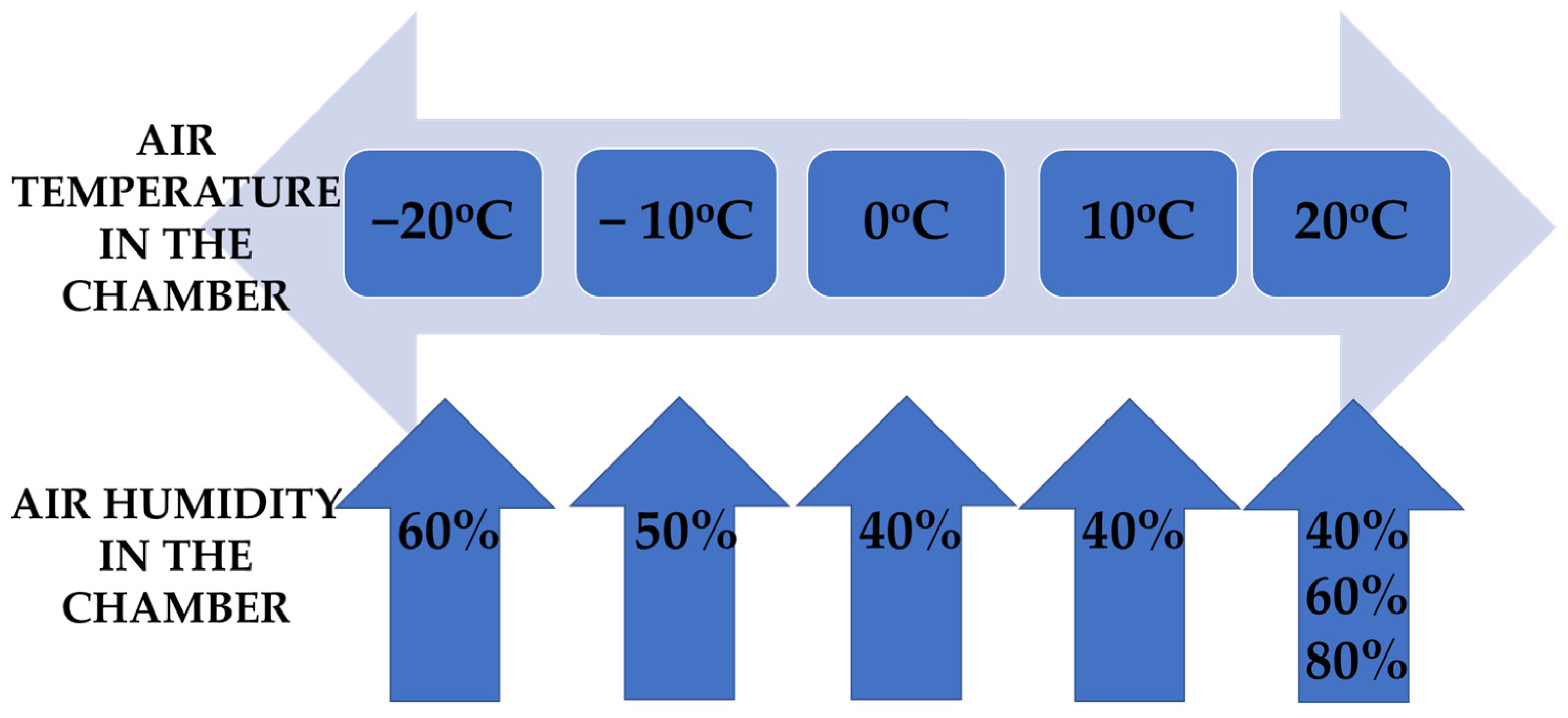
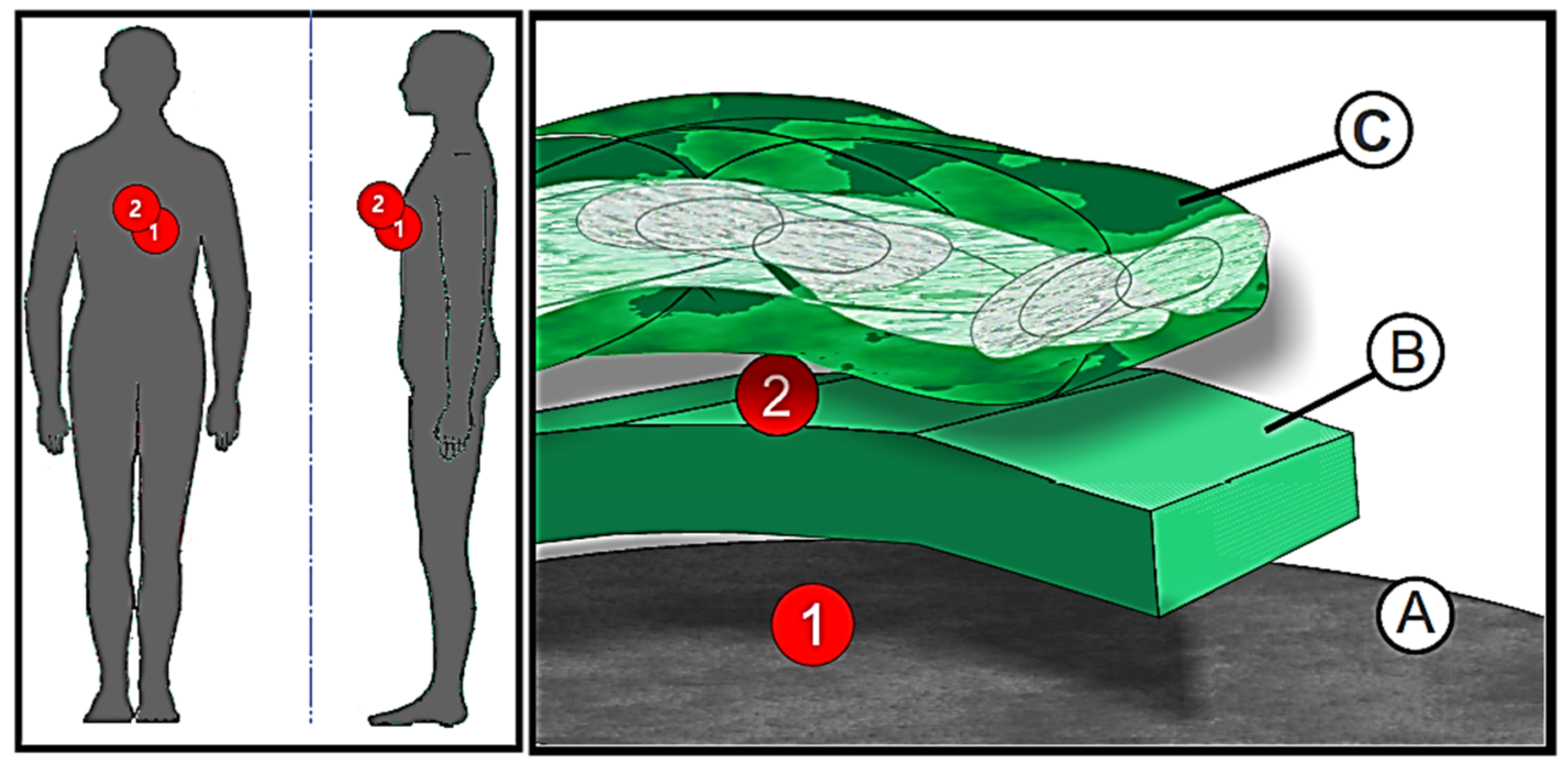
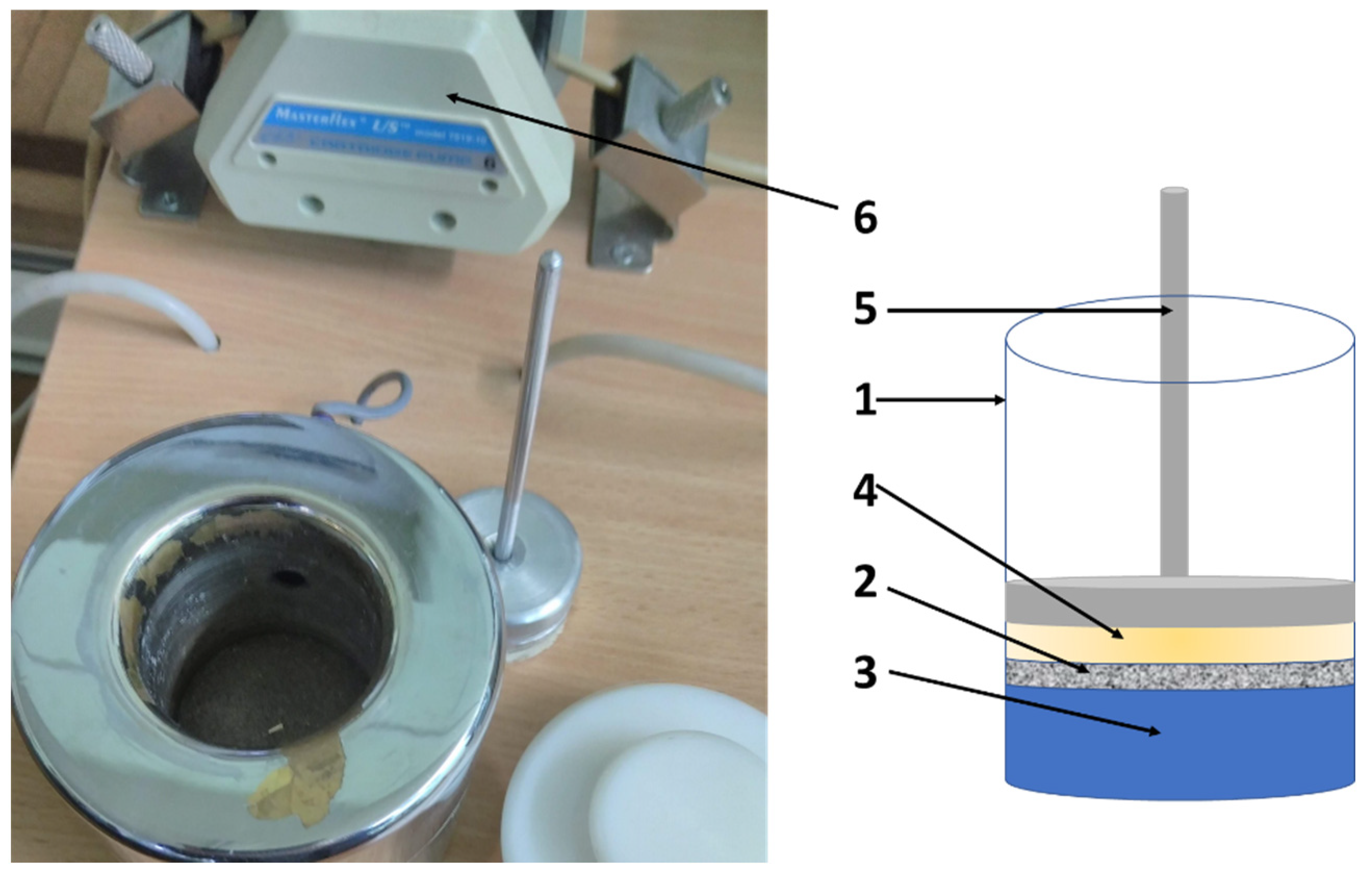
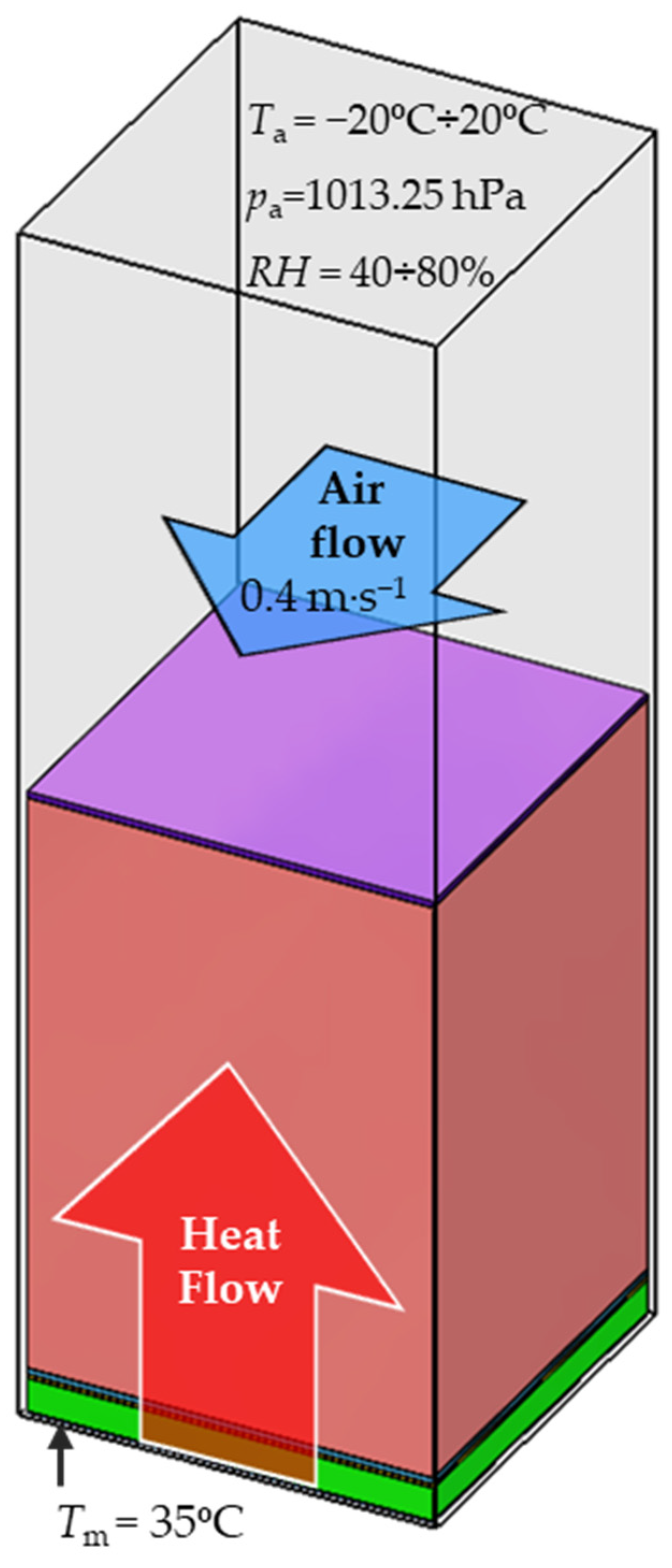
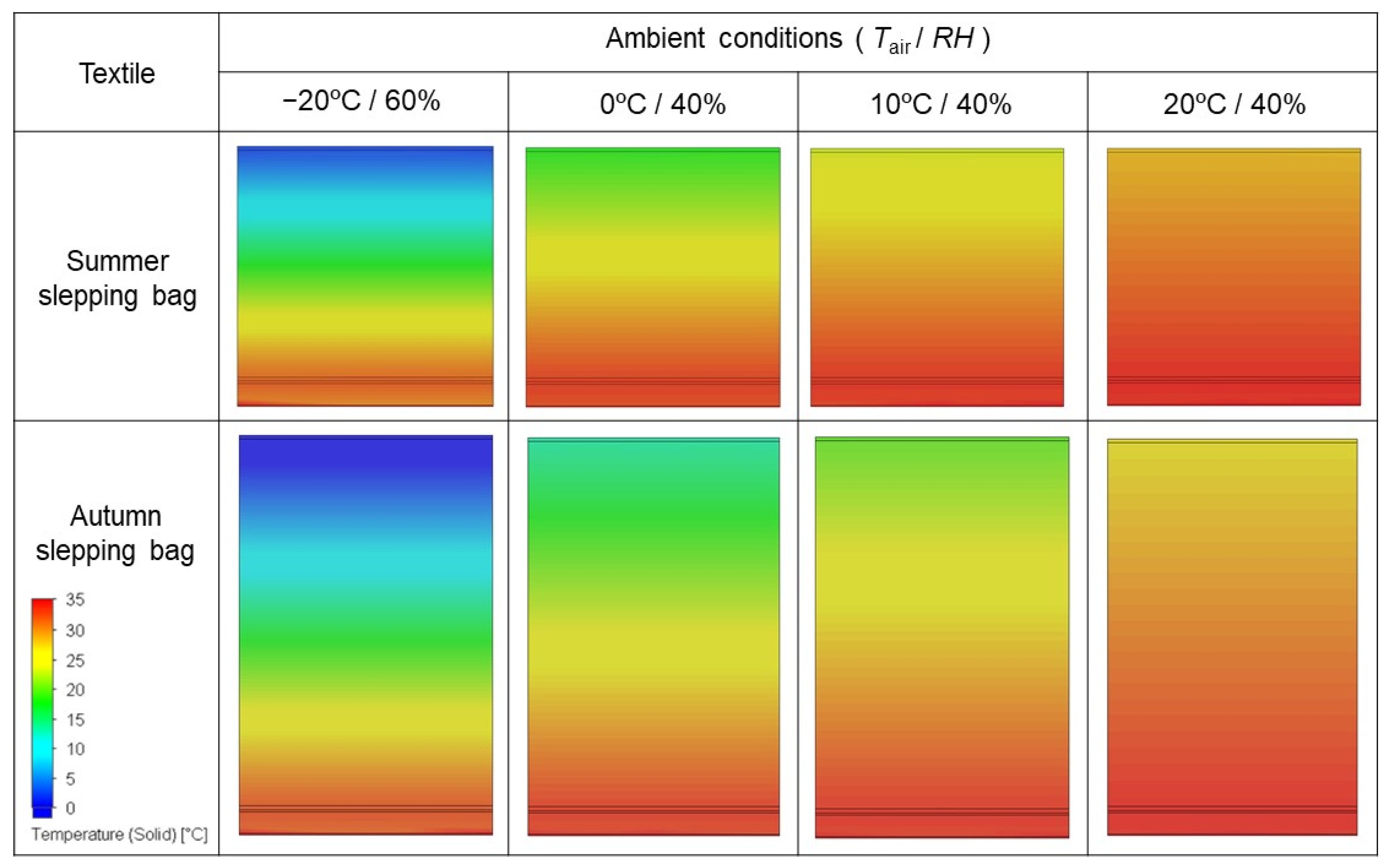
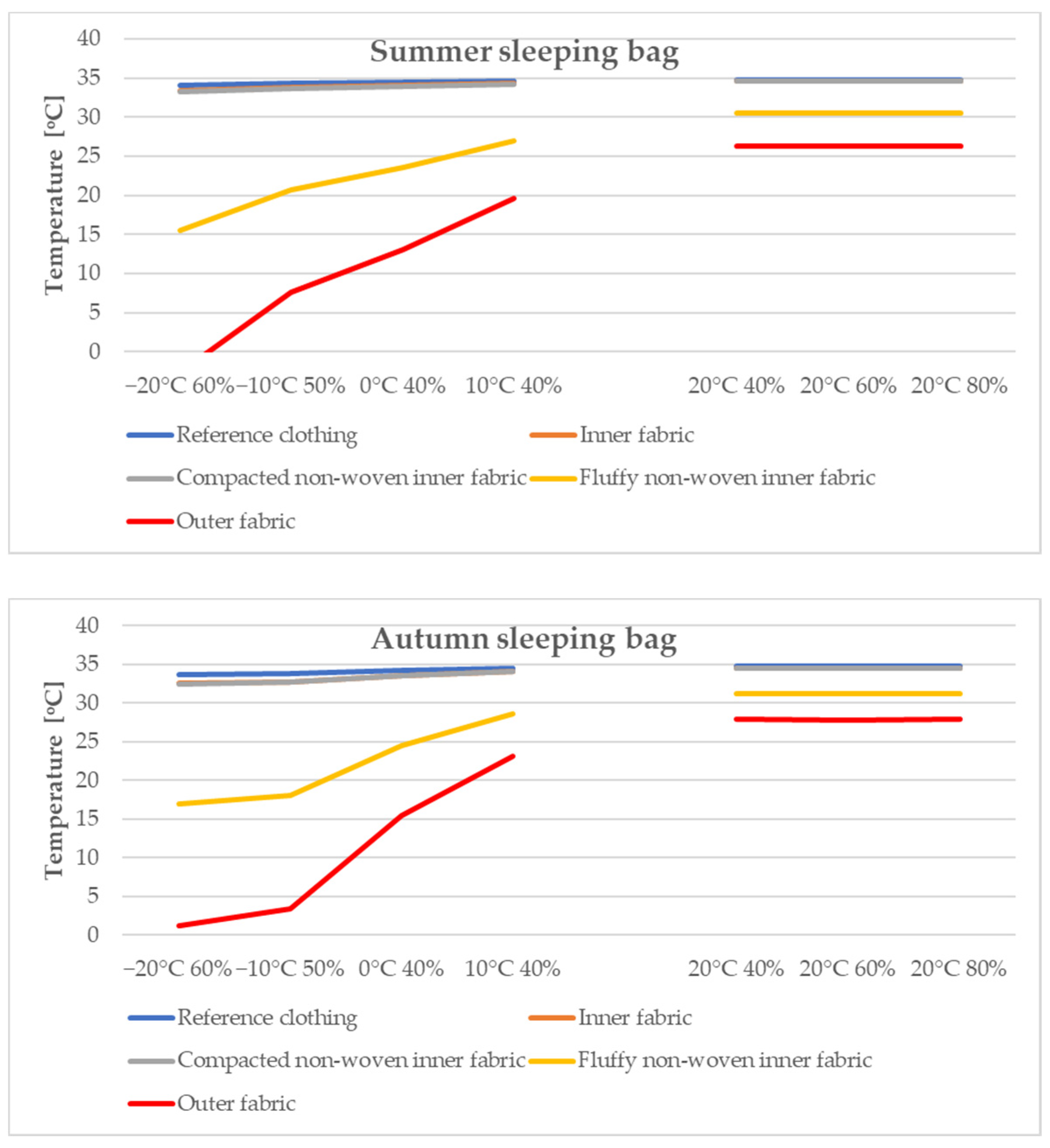

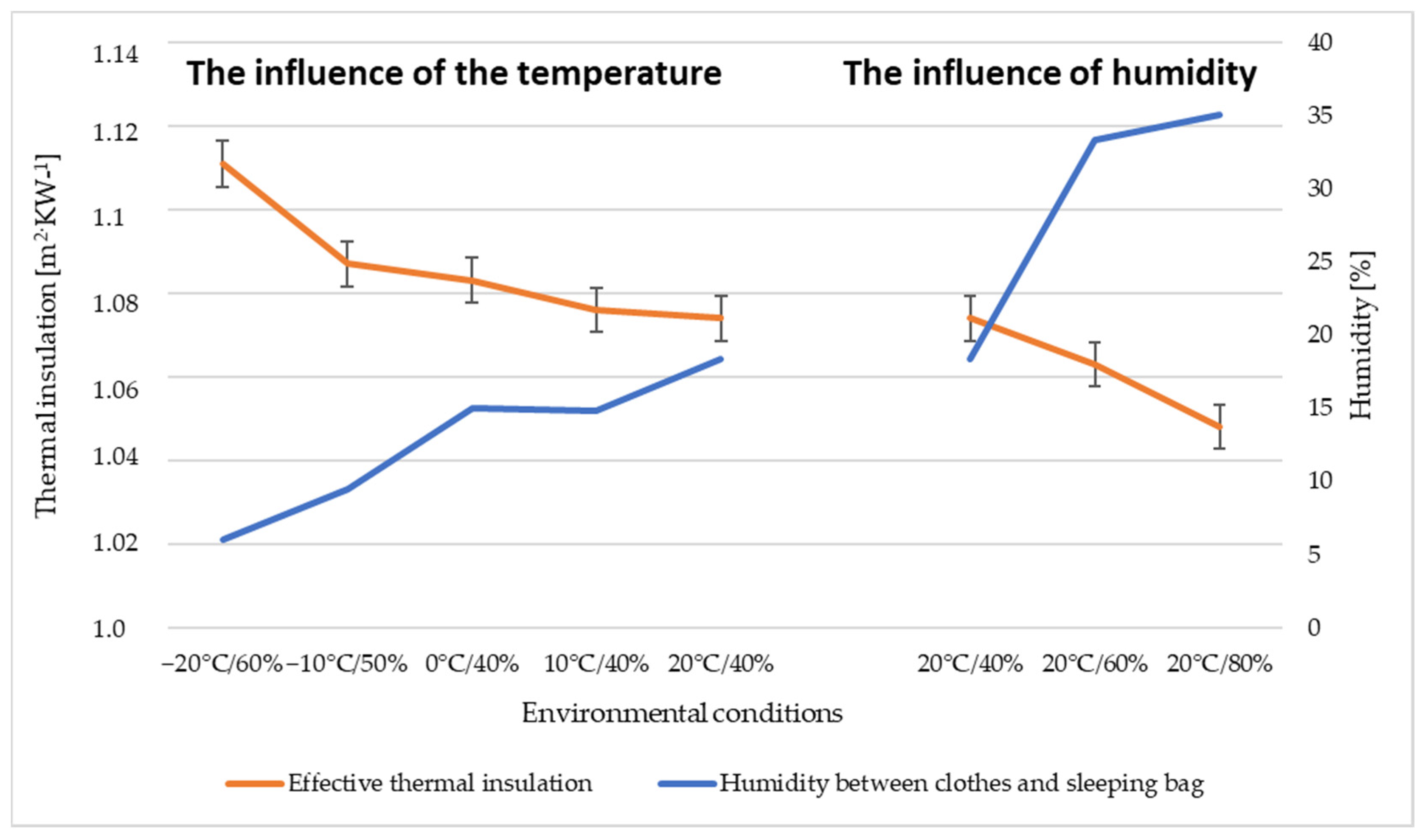
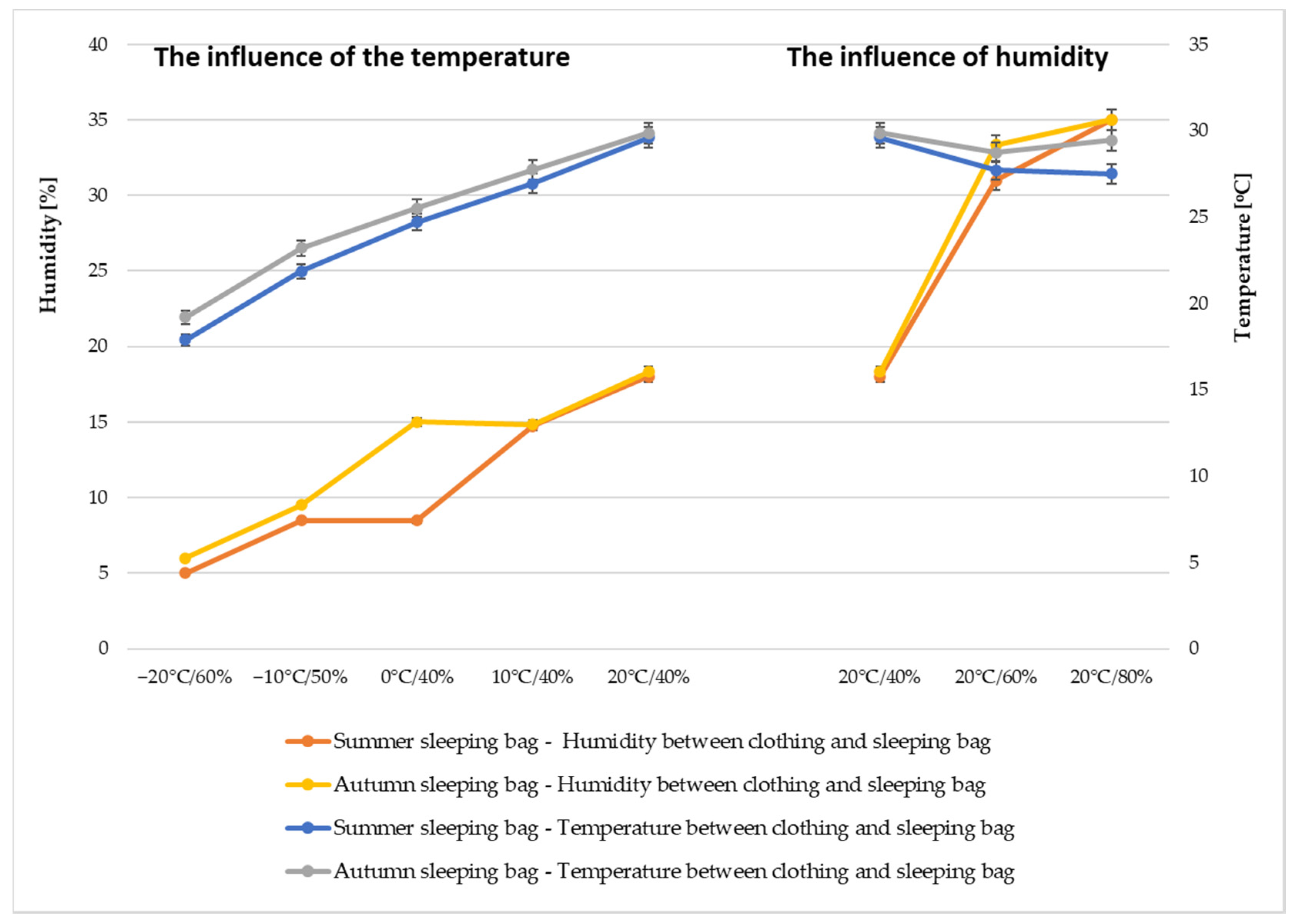

| Surface Weight of the Sleeping Bag [g·m−2] (Coefficient of Variation [%]) | Summer Sleeping Bag 1.2 kg (3%) | Autumn Sleeping Bag 1.8 kg (3%) | Raw Material Layer Composition |
|---|---|---|---|
| Outer fabric | 66 ± 4 | 66 ± 4 | PA fabric, khaki dyed with panther print and waterproof finish |
| Fluffy non-woven inner fabric | 60 ± 5 | 133 ± 7 | Heat-sealed nonwoven fabric PES 100% |
| Compacted non-woven inner fabric | 15 ± 1 | 15 ± 1 | Compacted flat non-woven PP |
| Inner fabric | 57 ± 3 | 57 ± 3 | PA fabric, khaki dyed |
| Physical Parameter | |||||
|---|---|---|---|---|---|
| Surface | Raw Material | Density [kg·m−3] | Specific Heat [J·kg−1·°C−1] | Thermal Conductivity [W·m−1·°C−1] | Porosity [%] |
| Reference clothing | PET knitted fabric | 1370 | 1380 | 0.08 | 39 |
| Outer fabric | PA fabric, khaki dyed with panther print and waterproof finish | 1230 | 2050 | 0.22 | 19 |
| Fluffy non-woven inner fabric | Heat-sealed nonwoven fabric PET | 1370 | 1380 | 0.084 | 61 |
| Compacted non-woven inner fabric | Compacted flat non-woven PP | 940 | 1720 | 0.26 | 61 |
| Inner fabric | PA fabric, khaki dyed | 1230 | 2050 | 0.22 | 20 |
| Air | - | 1.2 | 1005 | 0.03 | - |
| Model | Solid Cells | Gas Cells | Partial Cells |
|---|---|---|---|
| Summer sleeping bag | 8232 | 1480 | 532 |
| Autumn sleeping bag | 5880 | 1684 | 484 |
| Air Temperature [°C] | Air Humidity [%] | Established Thermal Conductivity Coefficient [W·m−1·°C−1] | Temperature Differences Between the Outer Fabric and the Reference Clothing [°C·m−1] | Heat Transfer Coefficient [W] |
|---|---|---|---|---|
| Summer sleeping bag | ||||
| −20 | 60 | 0.584 | −36.69 | 21.42 |
| −10 | 50 | 0.584 | −26.73 | 15.59 |
| 0 | 40 | 0.584 | −21.43 | 12.50 |
| 10 | 40 | 0.584 | −15.09 | 8.76 |
| 20 | 40 | 0.584 | −8.46 | 4.94 |
| 20 | 60 | 0.584 | −8.46 | 4.94 |
| 20 | 80 | 0.584 | −8.46 | 4.94 |
| Autumn sleeping bag | ||||
| −20 | 60 | 0.584 | −32.50 | 18.89 |
| −10 | 50 | 0.584 | −30.43 | 17.75 |
| 0 | 40 | 0.584 | −18.81 | 10.90 |
| 10 | 40 | 0.584 | −11.42 | 6.70 |
| 20 | 40 | 0.584 | −6.87 | 3.97 |
| 20 | 60 | 0.584 | −6.87 | 3.97 |
| 20 | 80 | 0.584 | −6.87 | 3.97 |
| Air Temperature [°C] | Air Humidity [%] | Thermal Insulation of the Naked Mannequin [m2·°C ·W−1] | Thermal Insulation of Reference Clothing [m2·°C ·W−1] | |
|---|---|---|---|---|
| Total | Effective | |||
| −20 | 60 | 0.100 ± 0.003 | 0.271 ± 0.004 | 0.171 ± 0.003 |
| −10 | 50 | 0.101 ± 0.003 | 0.304 ± 0.004 | 0.179 ± 0.003 |
| 0 | 40 | 0.106 ± 0.003 | 0.311 ± 0.004 | 0.184 ± 0.004 |
| 10 | 40 | 0.113 ± 0.003 | 0.324 ± 0.004 | 0.190 ± 0.004 |
| 20 | 40 | 0.120 ± 0.003 | 0.310 ± 0.004 | 0.190 ± 0.004 |
| 20 | 60 | 0.121 ± 0.003 | 0.313 ± 0.004 | 0.192 ± 0.003 |
| 20 | 80 | 0.122 ± 0.003 | 0.315 ± 0.004 | 0.193 ± 0.003 |
| Air Temperature [°C] | Air Humidity [%] | Thermal Insulation [m2·°C ·W−1] Summer Sleeping Bag | |
|---|---|---|---|
| Total | Effective | ||
| −20 | 60 | 0.951 ± 0.004 | 0.851 ± 0.004 |
| −10 | 50 | 0.929 ± 0.004 | 0.828 ± 0.004 |
| 0 | 40 | 0.921 ± 0.004 | 0.815 ± 0.003 |
| 10 | 40 | 0.908 ± 0.004 | 0.796 ± 0.003 |
| 20 | 40 | 0.915 ± 0.004 | 0.795 ± 0.004 |
| 20 | 60 | 0.915 ± 0.004 | 0.794 ± 0.004 |
| 20 | 80 | 0.917 ± 0.003 | 0.795 ± 0.003 |
| Parameters Set in the Chamber | Parameters Recorded with Sensors | ||||
|---|---|---|---|---|---|
| Location of Sensors | Summer Sleeping Bag | Autumn Sleeping Bag | |||
| Air Temperature [°C] | Air Humidity [%] | Air Temperature [°C] | Air Humidity [%] | ||
| −20 °C 60% | Between body of the mannequin and clothing | 28.80 ± 0.15 | 7.67 ± 1.20 | 29.10 ± 0.01 | 7.80 ± 0.01 |
| Between clothing and sleeping bag | 17.87 ± 0.64 | 5.00 ± 0.79 | 19.20 ± 0.01 | 6.00 ± 0.01 | |
| −10 °C 50% | Between body of the mannequin and clothing | 29.33 ± 0.01 | 10.00 ± 0.41 | 30.80 ± 0.01 | 10.50 ± 0.41 |
| Between clothing and sleeping bag | 21.85 ± 0.07 | 8.50 ± 0.42 | 23.20 ± 0.01 | 9.50 ± 0.42 | |
| 0 °C 40% | Between body of the mannequin and clothing | 31.20 ± 0.07 | 10.00 ± 1.28 | 32.10 ± 0.16 | 16.50 ± 1.22 |
| Between clothing and sleeping bag | 24.70 ± 0.62 | 8.50± 0.66 | 25.50 ± 0.13 | 15.00 ± 0.81 | |
| 10 °C 40% | Between body of the mannequin and clothing | 33.63 ± 0.62 | 13.75 ± 0.29 | 34.10 ± 0.10 | 15.67 ± 1.20 |
| Between clothing and sleeping bag | 26.95 ± 0.04 | 14.75 ± 0,55 | 27.73 ± 0.03 | 14.83 ± 1.33 | |
| 20 °C 40% | Between body of the mannequin and clothing | 34.80 ± 0.01 | 18.00 ± 0.01 | 36.07 ± 0.03 | 19.33 ± 0.33 |
| Between clothing and sleeping bag | 29.60 ± 0.02 | 18.00 ± 0.01 | 29.87 ± 0.03 | 18.33 ± 0.33 | |
| 20 °C 60% | Between body of the mannequin and clothing | 33.90 ± 0.01 | 29.00 ± 0.01 | 36.13 ± 0.03 | 29.33 ± 1.20 |
| Between clothing and sleeping bag | 27.70 ± 0.01 | 31.00 ± 0.01 | 28.73 ± 0.66 | 33.33 ± 0.88 | |
| 20 °C 80% | Between body of the mannequin and clothing | 34.33 ± 0.01 | 35.00 ± 0.01 | 34.50 ± 1.22 | 35.06 ± 1.63 |
| Between clothing and sleeping bag | 27.50 ± 0.03 | 35.00 ± 0.01 | 29.45 ± 0.88 | 35.00 ± 1.29 | |
| Air Temperature [°C] | Air Humidity [%] | Thermal Insulation [m2·°C·W−1] Autumn Sleeping Bag | |
|---|---|---|---|
| Total | Effective | ||
| −20 | 60 | 1.211 ± 0.004 | 1.111 ± 0.004 |
| −10 | 50 | 1.188 ± 0.004 | 1.087 ± 0.004 |
| 0 | 40 | 1.189 ± 0.004 | 1.083 ± 0.004 |
| 10 | 40 | 1.189 ± 0.003 | 1.076 ± 0.004 |
| 20 | 40 | 1.194 ± 0.004 | 1.074 ± 0.005 |
| 20 | 60 | 1.184 ± 0.004 | 1.063 ± 0.004 |
| 20 | 80 | 1.170 ± 0.004 | 1.048 ± 0.004 |
| Air Permeability [mm/s] | Standard Deviation [mm/s] | Coefficient of Variation [%] | |
|---|---|---|---|
| Summer sleeping bag | 0.694 | 0.421 | 60.663 |
| Autumn sleeping bag | 0.516 | 0.212 | 41.085 |
| Components of the Sleeping Bag | Maximum Sorption [μl cm−2] | Waterproofness [mmH2O] | Raw Material Composition of the Layer |
|---|---|---|---|
| Outer fabric | 1.26 ± 0.2 | 714.28 ± 5 | PA fabric, khaki dyed, with panther print and waterproof finish |
| Fluffy non-woven inner fabric | 9.57 ± 0.3 | permeation | Heat-sealed nonwoven fabric PES 100% |
| Non-woven inner fabric | 8.43 ± 0.3 | permeation | Compacted flat non-woven PP |
| Inner fabric | 3.69 ± 0.2 | 357.14 ± 4 | PA fabric, khaki dyed |
| Type of Sleeping Bag | Environmental Conditions | Thermal Insulation [m2·°C·W−1] | Extreme Temperature (Text) [°C]. | Limit Temperature (Tlim) [°C]. | Comfort Temperature (Tcomf) [°C]. |
|---|---|---|---|---|---|
| Summer sleeping bag | −20 °C/60% | 0.851 | −14.150 | 0.707 | 5.659 |
| −10 °C/50% | 0.828 | −12.319 | 2.179 | 6.833 | |
| 0 °C/40% | 0.815 | −12.126 | 2.213 | 6.942 | |
| 10 °C/40% | 0.804 | −11.962 | 2.244 | 7.037 | |
| 20 °C/40% | 0.791 | −10.242 | 3.550 | 7.987 | |
| 20 °C/60% | 0.791 | −10.242 | 3.550 | 7.987 | |
| 20 °C/80% | 0.804 | −11.962 | 2.244 | 7.037 | |
| Autumn sleeping bag | −20 °C/60% | 1.111 | −26.765 | −8.181 | −1.919 |
| −10 °C/50% | 1.087 | −25.124 | −6.971 | −0.918 | |
| 0 °C/40% | 1.083 | −25.032 | −6.945 | −0.915 | |
| 10 °C/40% | 1.081 | −24.985 | −6.933 | −0.914 | |
| 20 °C/40% | 1.067 | −24.662 | −6.744 | −0.705 | |
| 20 °C/60% | 1.099 | −26.476 | −8.093 | −1.898 | |
| 20 °C/80% | 1.15 | −28.750 | −9.583 | −3.127 |
Publisher’s Note: MDPI stays neutral with regard to jurisdictional claims in published maps and institutional affiliations. |
© 2022 by the authors. Licensee MDPI, Basel, Switzerland. This article is an open access article distributed under the terms and conditions of the Creative Commons Attribution (CC BY) license (https://creativecommons.org/licenses/by/4.0/).
Share and Cite
Skrzetuska, E.; Agier, M.; Krucińska, I. Study of Influence of Atmospheric Conditions on the Thermal Properties of Sleeping Bags. Materials 2022, 15, 1992. https://doi.org/10.3390/ma15061992
Skrzetuska E, Agier M, Krucińska I. Study of Influence of Atmospheric Conditions on the Thermal Properties of Sleeping Bags. Materials. 2022; 15(6):1992. https://doi.org/10.3390/ma15061992
Chicago/Turabian StyleSkrzetuska, Ewa, Michał Agier, and Izabella Krucińska. 2022. "Study of Influence of Atmospheric Conditions on the Thermal Properties of Sleeping Bags" Materials 15, no. 6: 1992. https://doi.org/10.3390/ma15061992
APA StyleSkrzetuska, E., Agier, M., & Krucińska, I. (2022). Study of Influence of Atmospheric Conditions on the Thermal Properties of Sleeping Bags. Materials, 15(6), 1992. https://doi.org/10.3390/ma15061992








